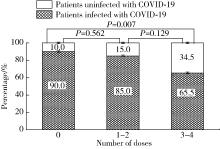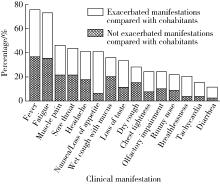Journal of Peking University (Health Sciences) ›› 2024, Vol. 56 ›› Issue (6): 1041-1046. doi: 10.19723/j.issn.1671-167X.2024.06.015
Previous Articles Next Articles
COVID-19 vaccines efficacy and infection features in patients with systemic sclerosis: A single-center cohort study
Wei PAN1,2, Yun LI1, Junjia LUO3, Chun LI1, Hua YE1, Xue LI1,*( ), Yuan JIA1,*(
), Yuan JIA1,*( )
)
- 1. Department of Rheumatology and Immunology, Peking University People' s Hospital, Beijing 100044, China
2. Department of Clinical Laboratory, 923 Hospital of the Chinese People' s Liberation Army Joint Logistic Support Force, Nanning 530021, China
3. Department of Rheumatism and Immunology, Longhua District People' s Hospital, Shenzhen 518110, Guangdong, China
CLC Number:
- R593.2
| 1 | Lepri G , Di Battista M , Codullo V , et al.Systemic sclerosis: One year in review 2024[J].Clin Exp Rheumatol,2024,42(8):1517-1528. |
| 2 |
Teles MS , Brundage J , Chiang TP , et al.Prevalence and risk factors of post-acute sequela of COVID-19 in adults with systemic autoimmune rheumatic diseases[J].J Rheumatol,2024,51(9):928-933.
doi: 10.3899/jrheum.2023-1212 |
| 3 |
Perveen S , Samreen S , Gul H , et al.Effect of disease activity on the clinical outcome of SARS CoV-2 in patients with underlying rheumatic diseases; data from global rheumatology alliance[J].J Pak Med Assoc,2024,74(6):1055-1060.
doi: 10.47391/JPMA.9371 |
| 4 | 新型冠状病毒感染诊疗方案(试行第十版)[J]. 中国医药, 2023, 18(2): 161-166. |
| 5 | Pattanaik D , Brown M , Postlethwaite BC , et al.Pathogenesis of systemic sclerosis[J].Front Immunol,2015,6,272. |
| 6 |
Ding Z , Wei X , Pan H , et al.Unveiling the intricacies of COVID- 19: Autoimmunity, multi-organ manifestations and the role of autoantibodies[J].Scand J Immunol,2024,99(2):e13344.
doi: 10.1111/sji.13344 |
| 7 |
Denton CP , Campochiaro C , Bruni C , et al.COVID-19 and systemic sclerosis: Rising to the challenge of a pandemic[J].J Scleroderma Relat Disord,2021,6(1):58-65.
doi: 10.1177/2397198320963393 |
| 8 |
Liu Y , Sawalha AH , Lu Q .COVID-19 and autoimmune diseases[J].Curr Opin Rheumatol,2021,33(2):155-162.
doi: 10.1097/BOR.0000000000000776 |
| 9 |
Jung SW , Jeon JJ , Kim YH , et al.Long-term risk of autoimmune diseases after mRNA-based SARS-CoV2 vaccination in a Korean, nationwide, population-based cohort study[J].Nat Commun,2024,15(1):6181.
doi: 10.1038/s41467-024-50656-8 |
| 10 | 朱玥桢, 李雪, 钟雪.自身免疫性疾病与新型冠状病毒肺炎疫苗接种[J].中国新药杂志,2022,31(14):1395-1401. |
| 11 | Güler AA , Özçimen B , Aydoǧdu MS , et al.Clinical characteristics and disease course before and after SARS-CoV-2 infection in a large cohort of systemic sclerosis patients[J].Turk J Med Sci,2023,54(1):76-85. |
| 12 |
Panopoulos S , Tzilas V , Bournia VK , et al.COVID-19 and protection of vaccination in patients with systemic sclerosis-associated interstitial lung disease[J].J Scleroderma Relat Disord,2023,8(2):113-119.
doi: 10.1177/23971983221143252 |
| 13 | Update to living WHO guideline on drugs for COVID-19[J]. BMJ, 2023, 383: 2622. |
| 14 | Talarico R , Ramirez GA , Barreira SC , et al.ERN ReCONNET points to consider for treating patients living with autoimmune rheumatic diseases with antiviral therapies and anti-SARS-CoV-2 antibody products[J].Clin Exp Rheumatol,2023,41(3):543-553. |
| 15 |
Prajjwal P , Marsool MDM , Yadav V , et al.Neurological, car-diac, musculoskeletal, and renal manifestations of scleroderma along with insights into its genetics, pathophysiology, diagnostic, and therapeutic updates[J].Health Sci Rep,2024,7(4):e2072.
doi: 10.1002/hsr2.2072 |
| 16 | Ghosh S , Tanna D , Telang K , et al.Clinical and autoantibody profiles of systemic sclerosis patients: A cross-sectional study from North India[J].Indian J Dermatol Venereol Leprol,2023,1,1-7. |
| 17 | Hui M , Zhou J , Li M , et al.Digital gangrene in systemic sclerosis patients: Not only due to the microvascular disease[J].Clin Rheumatol,2024,43(3):1083-1092. |
| 18 | Ture HY , Lee NY , Kim NR , et al.Raynaud' s phenomenon: A current update on pathogenesis, diagnostic workup, and treatment[J].Vasc Specialist Int,2024,40,26. |
| 19 | Fairley JL , O' Rourke R , Puranik R , et al.Cardiac magnetic resonance imaging in systemic sclerosis: Heart involvement in high- resolution[J].Rheumatol Immunol Res,2024,5(2):83-92. |
| [1] | Kelin ZHAO, Xue XIA, Naixu SHI, Han ZHOU, Jingwen GAI, Ping LI. Expression and significance of ferroptosis marker 4-HNE in in vitro model of systemic sclerosis [J]. Journal of Peking University (Health Sciences), 2024, 56(6): 950-955. |
| [2] | Jinrong ZHU,Yana ZHAO,Wei HUANG,Weiwei ZHAO,Yue WANG,Song WANG,Chunyan SU. Clinical characteristics of COVID-19 infection in patients undergoing hemodialysis [J]. Journal of Peking University (Health Sciences), 2024, 56(2): 267-272. |
| [3] | Xin LIU,Xueying SHI,Jun LI. A case of COVID-19 associated ischemic colitis [J]. Journal of Peking University (Health Sciences), 2024, 56(2): 362-365. |
| [4] | Wen-gen LI,Xiao-dong GU,Rui-qiang WENG,Su-dong LIU,Chao CHEN. Expression and clinical significance of plasma exosomal miR-34-5p and miR-142-3p in systemic sclerosis [J]. Journal of Peking University (Health Sciences), 2023, 55(6): 1022-1027. |
| [5] | Jian-bin LI,Meng-na LYU,Qiang CHI,Yi-lin PENG,Peng-cheng LIU,Rui WU. Early prediction of severe COVID-19 in patients with Sjögren’s syndrome [J]. Journal of Peking University (Health Sciences), 2023, 55(6): 1007-1012. |
| [6] | Jin-hui LAI,Qi WANG,Jia-xiang JI,Ming-rui WANG,Xin-wei TANG,Ke-xin XU,Tao XU,Hao HU. Effects of delayed ureteral stents removal during the COVID-19 pandemic on the quality of life and psychological status of postoperative patients with urinary calculi [J]. Journal of Peking University (Health Sciences), 2023, 55(5): 857-864. |
| [7] | Zhuo-hua LIN,Ru-yi CAI,Yang SUN,Rong MU,Li-gang CUI. Methodology and clinical use of superb microvascular imaging in assessing micro-circulation changes of fingertips in systemic sclerosis [J]. Journal of Peking University (Health Sciences), 2023, 55(4): 636-640. |
| [8] | Zhi-yu KANG,Lei-lei WANG,Yong-zheng HAN,Xiang-yang GUO. Anesthesia management of athletes' operation in Beijing Olympic Winter Games [J]. Journal of Peking University (Health Sciences), 2022, 54(4): 770-773. |
| [9] | Ming-long CHEN,Xiao-han LIU,jing GUO. Relationship between social support and parental burnout in COVID-19 among Chinese young parents [J]. Journal of Peking University (Health Sciences), 2022, 54(3): 520-525. |
| [10] | Hong MENG,Li-na JI,Jing HUANG,Shuang CHAO,Jia-wen ZHOU,Xue-jun LI,Xiao-mei YIN,Li-rong FAN. Analysis of the changes and characteristics of pediatric outpatient visits in a general hospital in Beijing before and after the COVID-19 pandemic [J]. Journal of Peking University (Health Sciences), 2021, 53(5): 952-956. |
| [11] | MA Xiang-bo,ZHANG Xue-wu,JIA Ru-lin,GAO Ying,LIU Hong-jiang,LIU Yu-fang,LI Ying-ni. Application of lymphocytes test in peripheral blood of patients with systemic sclerosis during the treatment [J]. Journal of Peking University (Health Sciences), 2021, 53(4): 721-727. |
| [12] | HUANG Bing, WANG Hong-yuan. Analysis of the development trend and severity of the COVID-19 panidemic in the global world [J]. Journal of Peking University (Health Sciences), 2021, 53(3): 536-542. |
| [13] | Jing ZHAO,Feng SUN,Yun LI,Xiao-zhen ZHAO,Dan XU,Ying-ni LI,Yu-hui LI,Xiao-lin SUN. Significance of anti-tubulin-α-1C autoantibody in systemic sclerosis [J]. Journal of Peking University (Health Sciences), 2020, 52(6): 1009-1013. |
| [14] | Qiu WANG,Jin-yu GUO,Hong SUN,Ling WANG,Ju-su YING,Hui-xin LIU. Investigation of protective exposure risk events in nurses against corona virus disease 2019 in Wuhan [J]. Journal of Peking University (Health Sciences), 2020, 52(4): 711-714. |
| [15] | Hang YANG,Lin-cheng YANG,Rui-tao ZHANG,Yun-peng LING,Qing-gang GE. Risks factors for death among COVID-19 patients combined with hypertension, coronary heart disease or diabetes [J]. Journal of Peking University (Health Sciences), 2020, 52(3): 420-424. |
|
||



